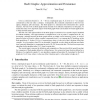Free Online Productivity Tools
i2Speak
i2Symbol
i2OCR
iTex2Img
iWeb2Print
iWeb2Shot
i2Type
iPdf2Split
iPdf2Merge
i2Bopomofo
i2Arabic
i2Style
i2Image
i2PDF
iLatex2Rtf
Sci2ools
COMPGEOM
2011
ACM
2011
ACM
Reeb graphs: approximation and persistence
Given a continuous function f : X → IR on a topological space X, its level set f−1 (a) changes continuously as the real value a changes. Consequently, the connected components in the level sets appear, disappear, split and merge. The Reeb graph of f summarizes this information into a graph structure. Previous work on Reeb graph mainly focused on its efficient computation. In this paper, we initiate the study of two important aspects of the Reeb graph which can facilitate its broader applications in shape and data analysis. The first one is the approximation of the Reeb graph of a function on a smooth compact manifold M without boundary. The approximation is computed from a set of points P sampled from M. By leveraging a relation between the Reeb graph and the so-called vertical homology group, as well as between cycles in M and in a Rips complex constructed from P, we compute the H1-homology of the Reeb graph from P. It takes O(n log n) expected time, where n is the size of the ...
| Added | 25 Aug 2011 |
| Updated | 25 Aug 2011 |
| Type | Journal |
| Year | 2011 |
| Where | COMPGEOM |
| Authors | Tamal K. Dey, Yusu Wang |
Comments (0)

